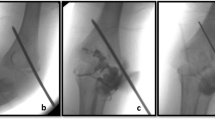Abstract
Purpose
The purpose of this study was to compare the surgical findings and clinical outcomes of the lateral condylar fractures of the humerus with or without posteromedial elbow dislocation in children.
Methods
Between January 2013 and June 2016, a total of 21 Milch type II humeral condylar fractures were treated with open reduction and internal fixation. The average follow-up was 2.8 years (range, 1 to 4 years). There were 8 patients in group A with posteromedial elbow dislocation and 13 patients in group B without dislocation. The surgical findings, bone union time, the recovery of function, and the time needed to regain full range of elbow movement were all compared. The complications encountered during operation and follow-up were documented.
Results
Surgical findings showed that all the fracture lines in group A extended to the lower medial part of the trochlea. The fracture lines in group B only involved the lateral and middle part of the trochlea. There were no significant differences in bone union time between the two groups. The time needed to regain full range of elbow movement after operation in group A (21 ± 4.0 weeks) was significantly longer in group B (17.85 ± 2.51 weeks; P < 0.05). There were no significant differences in MEPS, the flexion-extension arc, and the total range of flexion and extension between the two groups (P < 0.05).There was no difference in complications between the two groups (P < 0.05).
Conclusion
The fracture lines in Milch type II fractures of lateral humeral condyle with concomitant posteromedial elbow dislocation extend to the lower medial part of the trochlea. The soft tissue injuries are more badly so that longer time needed to regain full range of elbow movement. Initial recognition of this rare injury is essential to regain satisfactory functional outcomes.



Similar content being viewed by others
References
Flynn JM, Skaggs DL, Waters PM (2015) Rockwood and Wilkins’ fractures in children, 8th edn. Wolters Kluwer Health, Philadelphia, p 701
Royle SG (1991) Posterior dislocation of the elbow. Clin Orthop Relat Res 269:201
Pollen AG (1973) Fractures and dislocations in children. Churchill Livingstone, Edinburgh, pp 42–44
Morrey BF (1985) The elbow and its disorders. W.B. Saunders, Philadelphia, pp 277–288
Conner AN, Smith MG (1970) Displaced fractures of lateral humeral condyle in children. J Bone Joint Surg (Br) 52:460–464
Van Haaren ER, van Vugt AB, Bode PJ (1994) Posterolateral dislocation of the elbow with concomitant fracture of the lateral humeral condyle: case report. J Trauma 36:288–290
Carlioz H, Abols Y (1984) Posterior dislocation of the elbow in children. J Pediatr Orthop 4(1):8–12
Cheng PG, Chang WN, Wang MN (2009) Posteromedial dislocation of the elbow with lateral condyle fracture in children. J Chin Med Assoc 72(2):103–107
Pouliart N, De Boeck H (2002) Posteromedial dislocation of the elbow with associated intraarticular entrapment of the lateral epicondyle. J Orthop Trauma 16:53–56
Rovinsky D, Ferguson C, Younis A, Otsuka NY (1999) Pediatric elbow dislocation associated with a mi lch type I lateral condyle fracture of the humerus. J Orthop Trauma 13:458–460
Murnaghan JM, Thompson NS, Taylor TC, Cosgrove AP, Ballard J (2002) Fracture lateral epicondyle with associated elbow dislocation. Int J Clin Pract 56:475–477
DeLee JC, Wilkins KE, Rogers LF et al (1980) Fracture separation of the distal humeral epiphysis. J Bone Joint Surg Am 67:46–51
Moucha CS, Mason DE (2003) Distal humeral epiphyseal separation. Am J Orthop 32:497–500
Fowles JV, Kassab MT (1980) Displaced fracture of medial humeral condyle in children. J Bone Joint Surg 62:1159–1163
Hardacre JA, Nahigian SH, Froimson AI et al (1971) Fracture of the lateral condyle of humerus in children. J Bone Joint Surg Am 53:1083–1095
Houshian S, Mehdi B, Larsen MS (2001) The epidemiology of elbow fracture in children: analysis of 355 fractures, with special reference to supracondylar humerus fractures. J Orthop Sci 6:312–315
Landin LA, Danielsson LG (1986) Elbow fractures in children. An epidemiological analysis of 589 cases. Acta Orthop Scand 57:309–312
Author information
Authors and Affiliations
Ethics declarations
Conflict of interest
The authors declare that they have no conflict of interest.
Rights and permissions
About this article
Cite this article
Lan, X., Dai, M., Zhang, B. et al. Comparative study of lateral condyle fracture with or without posteromedial elbow dislocation in children. International Orthopaedics (SICOT) 42, 619–624 (2018). https://doi.org/10.1007/s00264-018-3795-0
Received:
Accepted:
Published:
Issue Date:
DOI: https://doi.org/10.1007/s00264-018-3795-0



